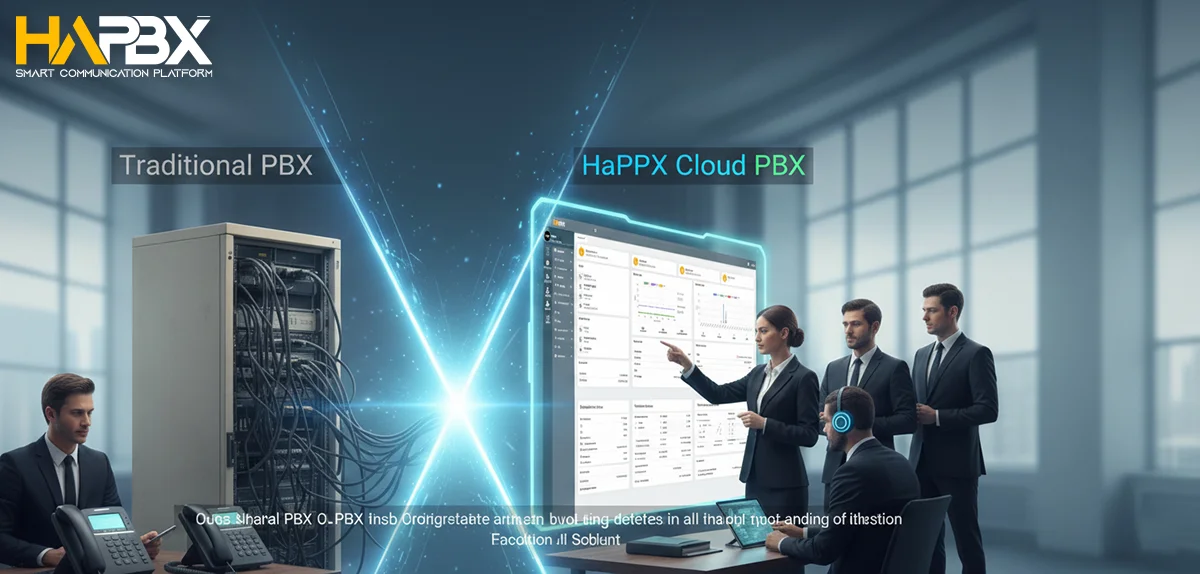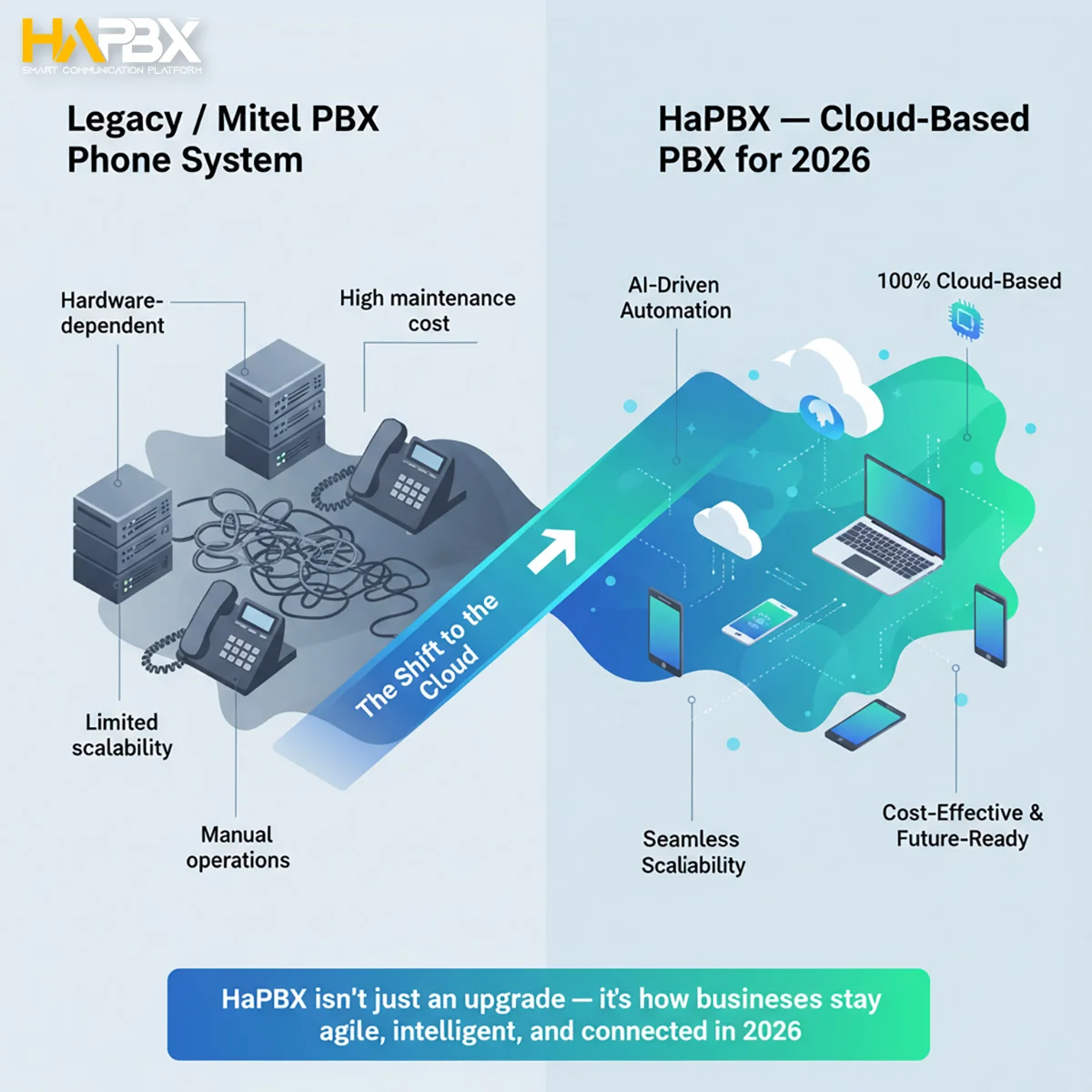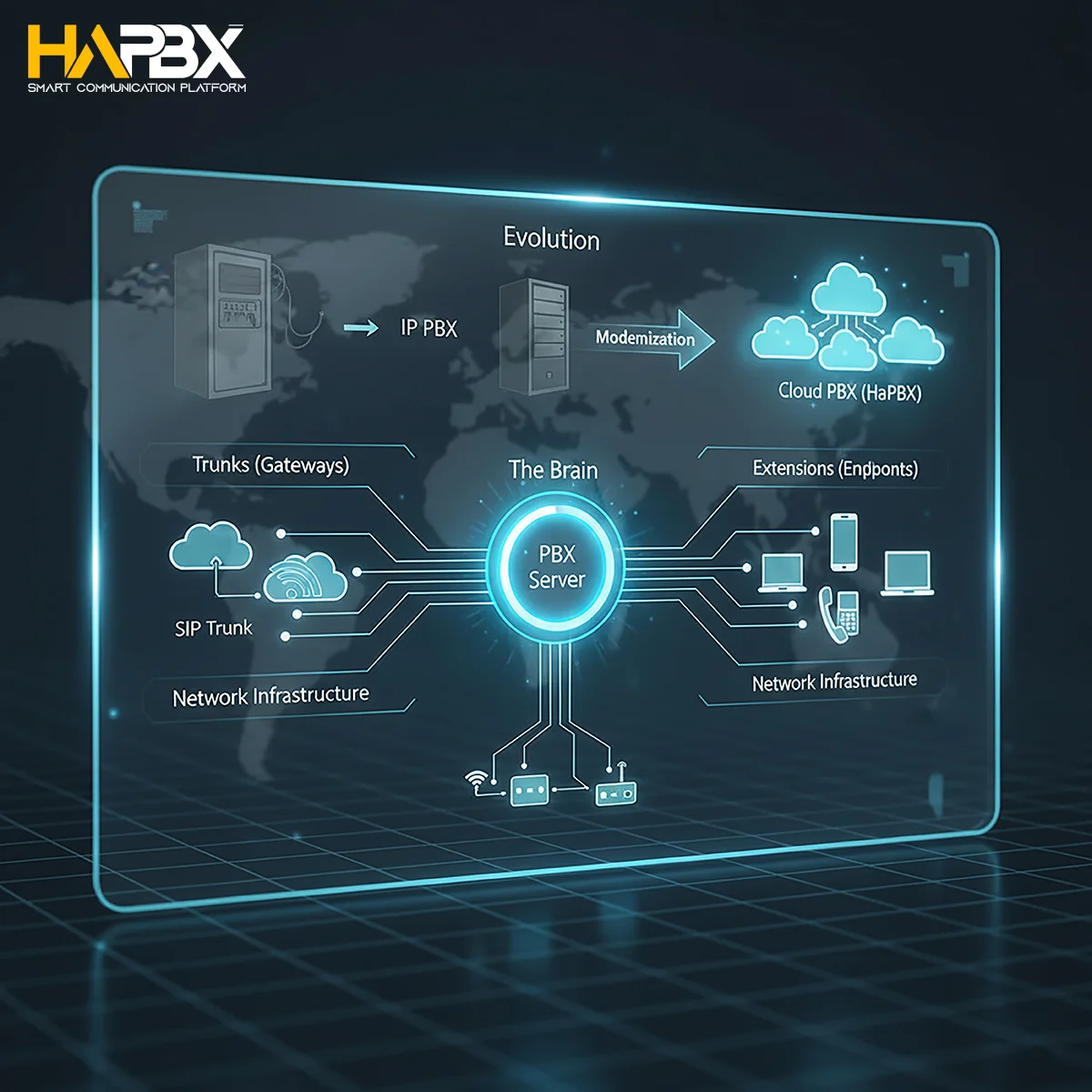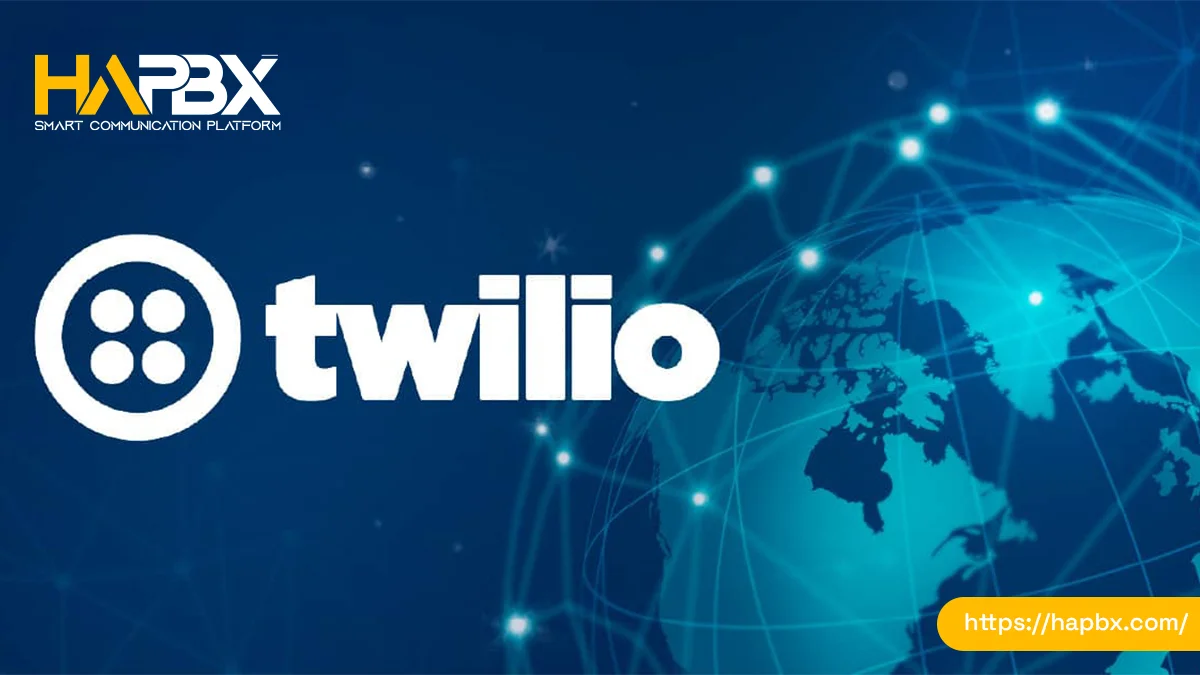As we move into 2026, one thing has become clear: the future of business communication is in the cloud. Legacy systems that once powered enterprises are now being replaced by smarter, faster, and more scalable solutions.
In this shift, many organizations that once relied on the Mitel PBX phone system are now turning toward HaPBX, a cloud-based communication platform designed to empower modern teams.
“HaPBX isn’t just an upgrade — it’s a strategic move toward automation, intelligence, and agility.”
It helps businesses cut operational costs, simplify infrastructure, and keep pace with the rapid evolution of digital transformation.
How Does a PBX System Work?
A Complete Guide to the Mitel PBX Phone System — and Why HaPBX Is Leading the Future in 2026
How you handle calls, direct inquiries, and connect your team defines your customer experience and operational efficiency. But as businesses evolve, a single phone line can quickly become a bottleneck. That’s where a PBX system steps in — acting as the central nervous system for modern business communications.
Many still picture PBX as a dusty closet full of tangled cables. In reality, the Mitel PBX phone system and next-generation solutions like HaPBX represent a revolution — smarter, cloud-based, and built for the digital enterprise.
As we move into 2026, adopting a PBX system isn’t just a smart move — it’s an inevitable step in future-proofing your communication infrastructure against the coming wave of automation, AI integration, and global connectivity.

The Core Concept: What Is a PBX System?
At its core, a PBX (Private Branch Exchange) is a private telephone network that connects employees internally and routes external calls efficiently. Think of it as your company’s personal telecom switchboard — customized, automated, and scalable.
Instead of having a separate phone line for every employee, a Mitel PBX phone system or a modern solution like HaPBX allows your business to share external lines while managing all inbound, outbound, and internal calls seamlessly.
This ensures professional, cost-effective communication across your entire organization — whether your team is in one office or spread across continents.
The Key Components of a Modern PBX System
To understand how the Mitel PBX phone system works, let’s break down its essential building blocks:
- PBX Server (The Brain): The central software that manages all call routing, logic, and features. In a cloud-based PBX like HaPBX, this is hosted securely offsite — no hardware or maintenance required.
- Trunks (The Gateway): Virtual connections (SIP Trunks) linking your PBX to the global phone network.
- Extensions (The Endpoints): Each user’s phone, softphone, or mobile app — all connected via the same network.
- Network Infrastructure: Uses your existing LAN/Wi-Fi, reducing cabling and simplifying deployment.
The Evolution of PBX: From Analog to Intelligent Cloud
PBX systems have evolved dramatically — from analog cabinets to intelligent, AI-ready cloud platforms.
- Traditional Analog PBX: Hardware-heavy, limited scalability, and costly maintenance.
- IP PBX: Introduced VoIP technology, transforming voice into digital data and enabling integration with CRMs, call recording, and voicemail-to-email.
- Cloud PBX (like HaPBX): The next leap — hosted entirely in the cloud, offering instant scalability, remote access, and 24/7 reliability.
This evolution makes both the Mitel PBX phone system and HaPBX indispensable in the hybrid workplace era.

A Step-by-Step Look: How PBX Manages a Call
- Inbound Call Arrives: The customer dials your business number. The call enters the PBX through a SIP Trunk.
- Smart Routing: The PBX checks business hours, activates IVR menus (“Press 1 for Sales…”), and routes the call to the right department.
- Connection & Control: The PBX links the caller with the right agent, enabling features like transfer, recording, and analytics.
Each step happens in milliseconds — ensuring every call is handled efficiently and professionally.
Why Cloud PBX Is the Future of Business Communication
By 2025, businesses around the world began to realize that traditional PBX systems were no longer sustainable. Hardware maintenance, limited mobility, and high IT costs made it difficult to stay agile in a global, hybrid workforce.
“Heading into 2026, adopting a cloud-based PBX is no longer an option — it’s an inevitable business upgrade. HaPBX was built to meet this moment.”
It delivers:
- Unified communication: Manage calls, video meetings, and messages from one dashboard.
- AI-driven call routing: Ensure every call reaches the right person instantly.
- CRM integrations: Connect directly with leading tools like Salesforce, HubSpot, and Zoho.
- 99.99% uptime: No local servers, no downtime, no disruptions.
- Scalable design: Expand to new teams or offices within minutes.

HaPBX vs Mitel PBX Phone System: A 2026 Comparison
While the Mitel PBX phone system has been a trusted name in business communications for years, it was built for an era where office-based work dominated. As businesses move into a remote and hybrid-first future, the need for cloud-native technology becomes undeniable.
| Feature / Capability | HaPBX (Cloud-based) | Mitel PBX Phone System (Legacy) |
| System Type | Fully cloud-native, no on-site hardware | Hybrid or on-premise infrastructure |
| Setup & Deployment | Instant setup, no IT support required | Requires manual installation and configuration |
| Scalability | Add users and branches in minutes | Complex expansion with additional hardware |
| Unified Communications | Built-in voice, video, chat, and CRM | Primarily voice-based system |
| Mobility & Remote Access | Accessible from any device, anywhere | Limited to physical office phones |
| AI & Automation | Intelligent call routing, insights, and analytics | Basic rule-based routing |
| Maintenance Costs | Fully managed cloud — zero maintenance | Ongoing server upkeep and IT labor |
| Integrations | Native with CRM, ERP, and UC platforms | Limited or third-party connectors |
| Uptime & Reliability | 99.99% uptime with global redundancy | Dependent on local infrastructure |
| Future-readiness (2026) | AI-powered, cloud-native, built for hybrid work | Requires modernization to stay relevant |
Why PBX Is the Future of Business Communications (2026 and Beyond)
The world is entering a hyperconnected era driven by AI, automation, and cloud-native technologies. Businesses that still rely on outdated phone systems will soon struggle to keep up with customer expectations and global operations.
Mitel PBX phone system or HaPBX equips your team with the speed, flexibility, and intelligence needed to stay ahead. From unified communications to CRM integration, it transforms voice calls into data-rich, actionable touchpoints — a foundation for the AI-powered enterprise of 2026.
The Future Is Intelligent, Not Static
In 2026, success will belong to organizations that can communicate, collaborate, and adapt faster than ever. Traditional systems like the Mitel PBX phone system were not built for the speed, flexibility, or intelligence required by today’s business environment.
HaPBX, on the other hand, redefines what’s possible.
It’s not just a communication tool — it’s an intelligent platform that evolves with your business, automates routine tasks, and empowers teams to deliver outstanding results.
With AI-powered analytics, automated workflows, and cloud reliability, HaPBX enables leaders to make smarter decisions, reduce costs, and scale operations without limits.

Why HaPBX Is the Smarter Choice
- Built for the cloud era: Fully virtual, secure, and accessible anywhere.
- AI-driven intelligence: Smart routing, real-time analytics, and predictive performance tracking.
- Optimized for business growth: From startups to enterprises, scale seamlessly with no downtime.
- Enterprise-grade security: End-to-end encryption and compliance-ready infrastructure.
“HaPBX isn’t just a replacement for the Mitel PBX phone system — it’s the evolution of business communication in the AI-driven world of 2026.”
Frequently Asked Questions About HaPBX and the Mitel PBX Phone System
1️⃣ What makes HaPBX different from a traditional or Mitel PBX phone system?
HaPBX takes the core reliability of the Mitel PBX phone system and brings it to the cloud — removing the need for bulky hardware, costly maintenance, and complex setups. With HaPBX, everything runs on a secure, cloud-native platform that scales instantly as your business grows. It’s the evolution of PBX built for AI-driven, hybrid workplaces in 2026.
2️⃣ How does HaPBX actually work?
HaPBX operates as a cloud-based Private Branch Exchange that connects all your business communication channels — desk phones, mobile apps, and softphones — under one system. When a customer calls, HaPBX intelligently routes the call to the right department or agent using IVR menus and smart routing. It ensures every call is handled efficiently, reducing wait times and boosting customer satisfaction.
3️⃣ Can HaPBX support remote and hybrid teams?
Absolutely. With HaPBX, your team can connect from anywhere — office, home, or on the go. Using the HaPBX mobile and desktop apps, employees can make and receive calls using the same business number, access call recordings, and collaborate in real time. This flexibility makes it an ideal communication hub for the modern hybrid workforce.
4️⃣ Is HaPBX secure for enterprise use?
Yes. HaPBX uses enterprise-grade encryption and data protection protocols to ensure all communications remain private and secure. The system is hosted on globally compliant cloud servers with continuous monitoring, automatic backups, and multi-layered security — giving businesses peace of mind while scaling operations globally.
5️⃣ Why is upgrading to a PBX system inevitable in 2026?
As automation, AI, and global collaboration become business standards, companies relying on legacy phone systems will quickly fall behind. The Mitel PBX phone system paved the way for digital communications, but solutions like HaPBX are now leading the transformation — delivering smarter analytics, AI integrations, and unified communication in one cloud-based platform.
Upgrade your business with HaPBX — where innovation meets intelligence.





